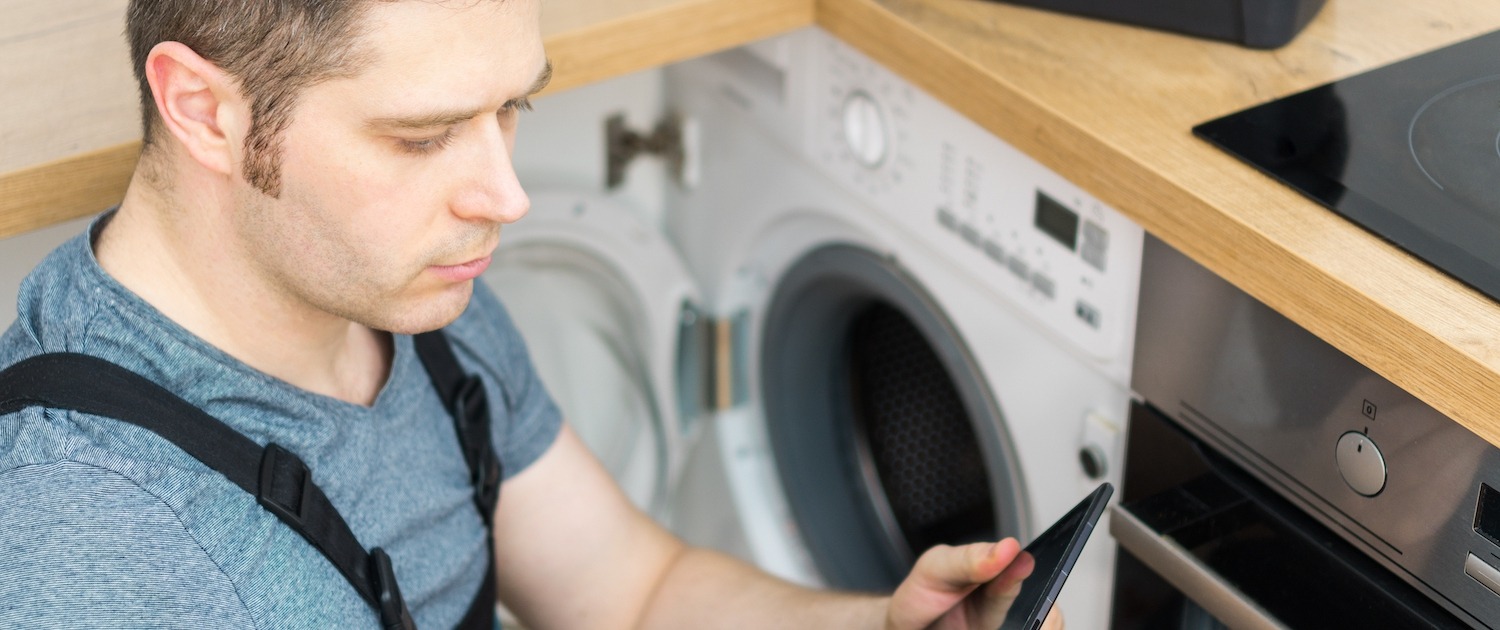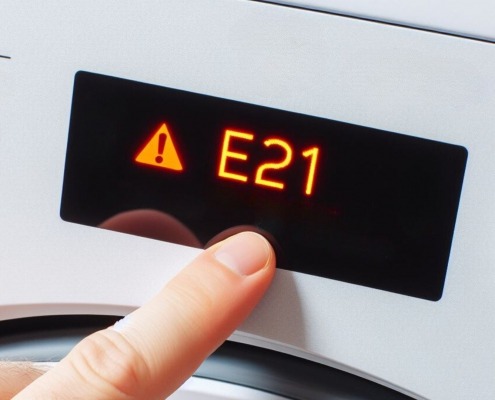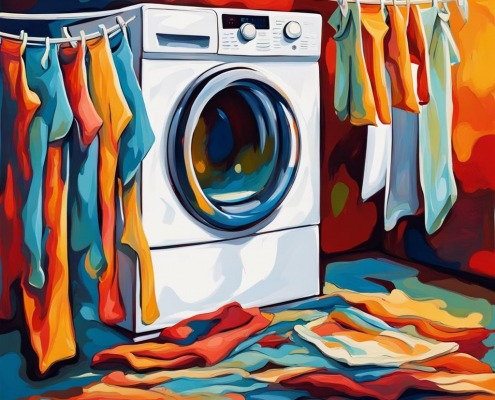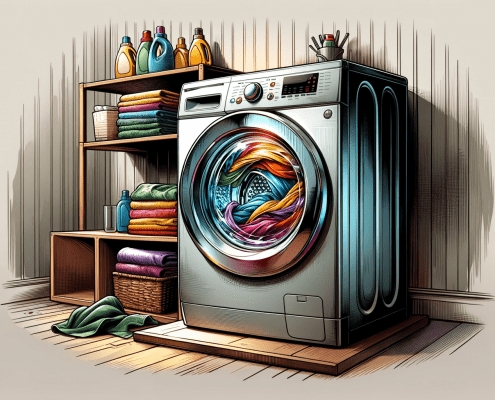How To Replace A Washer’s Spider Arm Assembly (with Video!)
APP Expert / Thursday January 13, 2022
Is your front-load washer making alarming banging noises during cycles? Chances are, a faulty spider arm assembly is the culprit. Don’t rush to replace your washer just yet—our handy guide and step-by-step video below show you how to tackle this repair yourself, saving you time and money. Let’s dive in!
Need to find the right spider arm assembly to fix your washer? Search below with your exactly model number to find the perfect part:
Are you hearing an awful lot of racket from your front-load washer? If it’s banging around every time you use it, there’s a pretty good chance that the spider arm assembly is to blame. Luckily, there’s no need to go shopping for a new appliance. This is absolutely a repair you can take care of yourself. A spider arm assembly, also called a basket spider or drum spider, is an aluminum part found in front-loading washers that holds the inner tub in place. There are usually six bolts, called spider bolts, holding the assembly to the back of the inner tub. In this guide and our video tutorial, we’ll be walking you through how to replace both. Let’s get started!
Signs That The Spider Arm Assembly Has Gone Bad
You’re most likely going to replace this part because the arms have cracked or corroded. If your washer is making banging noises when it runs, there’s a good chance the spider arms have failed and the tub has come unbalanced. Being that the spider arm assembly is made of aluminum, it is susceptible to corrosion. Exposure to water – especially hard water – or using too much detergent can cause corrosion and weaken the assembly. A corroded spider assembly will become brittle and eventually crack or crumble. To extend the life of your high efficiency appliance, always make sure you use the right amount of detergent.
Finding The Right Replacement Part
To find compatible OEM parts, you’ll need to start with your washer’s model number. If you don’t have your appliance’s manual, you can find that information on the machine itself. Check behind the washer door, either along the wall of the front panel or on the door itself, for a sticker that lists this information. You may also find the washer’s model number behind the kickplate or front access panel. We recommend replacing the spider bolts when replacing the spider arm assembly. In fact, it’s possible that one of the old bolts could break while you’re removing the old assembly, so having new ones on hand will save you from delays due to missing hardware. While you’re shopping, keep in mind that spider arm assemblies are typically sold without hardware, and each spider bolt is sold individually.
Once you have that model number, type it into our search bar below to find compatible OEM parts quickly! You’ll get what you need in just a few days.
How To Replace A Washer’s Spider Arm Assembly
The steps laid out in this guide were completed on a Samsung washer. If your washer is older, or is a different brand, you should still be able to use our walkthrough. The process is mostly the same from washer to washer! Be sure to check out our video guide above as well for a detailed look at each step.
Tools for the Job
Gather these materials before you begin:
- A new compatible spider arm assembly and six spider bolts
- A new outer tub seal (optional)
- Phillips & flathead screwdrivers
- Hammer
- Ratchet wrench
- Sockets: 19mm, 13mm, 10mm, 7mm
- Pliers
- Socket extender
- Work gloves
- Wood or cinder blocks
- Blue thread locker
Replacing A Washer’s Spider Arm Assembly & Spider Bolts
Part 1: Disassemble Your Washer
- Before you begin, make sure to disconnect your washing machine from power either at the wall outlet or the circuit breaker! Turn off the hot and cold water supplies as well.
- Remove the rear access panel. There’s one screw on each side and tabs on the top and bottom. After the screws are out, lift the panel up to free it from the lower tabs, then pull it away from the upper tabs.
- Disconnect the water temperature sensor and all other wires on the back of the tub. Refer to our video tutorial for a detailed look at how to disconnect each one!
- Remove the rotor.
- Start by loosening the nut holding the rotor in place. We needed a 19mm socket and ratchet to remove this part.
- The rotor still has magnets securing it to the stator. You’ll need to wiggle it to get it free.
- Remove the stator. Use a 10mm socket and socket extension to remove each bolt holding the stator in place.
- Remove the washer lid. Start by removing the screws that hold the lid on. Next, lift the top, pull it back an inch or two to clear it from the bracket holding it in place, and then remove it.
- Disconnect the hoses from the top of the washer tub. There’ll be a smaller one in the center of the tub, and a larger one connected to the back. You may need a screwdriver or pliers to loosen the clamps holding them in place.
- Remove the detergent drawer. It’s locked in place. Press the release to free it up.
- Remove the control panel.
- Start by removing the mounting screws across the top of the washer.
- Pull the console away from the washer and disconnect the wiring harnesses still tying it to the appliance.
- Lift the panel off the bottom mounting tabs and set it aside.
- Removing the front panel:
- Open the drain hose access panel. Unclip the drain hose and move it aside so that you can reach the screws. Remove both screws, set them aside, and close the access panel.
- Remove the three screws holding the door switch assembly in place. You can reach them by opening the washer door.
- Remove the door gasket clamp. Lift up on the very bottom of the gasket slightly to find the spring locking the gasket clamp in place. Carefully pry this spring out of the door groove with a flathead screwdriver, and then work your hand around the clamp to pull the rest of it free. Finally, push the door gasket in and out of the way of the front panel.
- Remove the four screws holding the front panel onto the washer bulkhead at the top.
- Lift up on the front panel slightly to clear it from a top locking tab, then slowly pull it away from the body of the washer.
- Make sure that the door switch and the drain hose are clear of the front panel before you remove it completely, then lift the panel up off its support brackets and set it aside.
- If you haven’t drained your washer yet, do so now. Uncap the drain hose over a water receptacle like a bowl or pan and empty the contents.
- Disconnect the hoses from the washer door gasket. There is probably a clamp holding in place, which you can release with a pair of pliers. You will likely also need to use a flathead screwdriver to pry the hose itself off. Our washer had just one gasket hose, but some models have two – one at the top and one at the bottom.
- Remove the inner door seal clamp and the gasket. On this Samsung washer, the clamp was held in place with a bolt. We used a 7mm socket and socket extension to remove it. If you’re having trouble getting the clamp out of the groove, you can pry it out with a flathead screwdriver.
- Other washer models may have inner clamps held in place with springs, in which case, you can repeat the process you used earlier to remove the first clamp.
- Remove the detergent dispenser hose. Use pliers to compress the clamp and slide it out of the way. The hose should come away by hand after that.
- Remove the washer tub weights. A 13mm socket can be used to remove the bolts holding the weights in place.
- Remove the water switch air pressure hose.
- The air pressure hose is held onto the tub by wire ties, so just untwist them to free up the hose.
- Then remove the pump hose, which is probably in the way of the air pressure hose. It’s held to the tub by a clamp that can be loosened with pliers.
- Finally, remove the two clamps holding the air pressure hose to the tub. There’s one in front held in place by a screw, and one in back that you can loosen with a pair of pliers.
- With both clamps off, you can remove the hose and push it out of the way.
- Disconnect the tank heater wires. You should find them right next to where the air pressure hose is. Our video shows you exactly how to remove these wires and their clamp.
- Remove the tub-to-pump hose from the bottom of the tub. You can loosen the clamp with a Phillips screwdriver.
- Remove the shock absorbers from the bottom of the tub. There will be two shocks in the front and two in the back. You’ll likely need a 13mm socket and ratchet to remove the bolts holding them in place. Pull the shocks down to free them from the tub and set them out of the way.
- Remove the suspension springs holding the tub in place.
- Start on the dispenser side. You’ll need to remove the screw holding the dispenser in place and slide the dispenser out of the washer bulkhead to give you room to access the first spring.
- Carefully unhook the first spring from the frame and lower the tub down to the bottom of the washer. Disconnect the spring from the tub and hook it back into its mounting point.
- Set the dispenser assembly back in place.
- On the opposite side, the spring is likely hidden by a hose or wire. Move that out of the way first. You may have to unhook some wire harness retainers.
- Lift the tub slightly so that it’s a little easier to unhook the other spring. Having an assistant on this part could help.
- Unhook the second spring and carefully lower the tub back down. Then remove the spring from the tub and hook it back into place at its mounting point.
- Take the tub assembly out of the washer body. Lift it and slide it forward. You may have to wiggle it a little to get it out. Once it’s out, set it up on a couple of wood or cinder blocks.
- Since you’ve got the washer tub all the way out, now is a great time to inspect the whole assembly for damage. Make sure all the bolts are in good shape and the outer tub isn’t cracked. You’ll be taking the outer tub apart next, so we recommend installing a new seal to replace the old one before you put everything back together.
- Remove all the screws holding the outer tub together with a 10mm ratchet. You may need to wedge a small flathead screwdriver between the two halves to split them. Once they’re separated, remove the top half of the outer tub.
- Remove the inner tub. It’s possible that your washer’s bearings have seized to the spider assembly. If you can’t just lift the inner tub out, you’ll need to flip the whole thing over and use a mallet or hammer to carefully pound the outer tub out.
Part 2: Replace Your Spider Arm Assembly
- With the inner tub out, check the tub’s seal and bearings to see if they need to be replaced. If they do, we can help you out there, too! Check out our how-to for washer bearings and seals.
- Clean up the outer tub, clearing out any debris. There’s a good chance there’s a lot of corrosion build up in there. Now would be a good time to check the interior of the outer tub for signs of damage, as well.
- Remove the spider arm assembly from the inner tub.
- Use a 10mm socket and ratchet to remove each of the six spider bolts holding the assembly in place.
- If a bolt head breaks off, don’t worry! You’ll just need to pry the spider arm up to get it all out of the tub. Save that for after you’ve removed all the other bolts.
- Once all the bolts are out (or broken), you can use a flathead screwdriver to pop the spider arm assembly out of place and get it off the tub. You may not have to do this, though.
- Use a 10mm socket and ratchet to remove each of the six spider bolts holding the assembly in place.
- Clean up the inner tub exterior in preparation for the new assembly. Tap the bolt holes flat with a metal hammer, too. This’ll make mounting the new assembly a little easier.
- Set the spider arm assembly into place. Tap on it gently to get it to settle properly if it isn’t going in all the way.
- Thread all six spider bolts into place and then tighten them with a socket and ratchet. If you are reusing old bolts, now’s the time to apply some blue thread locker. If you are using all new bolts, these should come with the thread locker pre-applied.
At this point, your new parts are installed and all that’s left is to reassemble everything. Mostly, you’re just repeating all those disassembly steps in reverse. We’ll cover that briefly in the next section. For more detailed instructions, check out our companion video.
Part 3: Reassemble Your Washer
- Reseat the inner tub. Make sure the wave washer is back in place first and then line the shaft up and carefully lower the inner tub.
- Put the outer tub back together. Make sure the heating element is slotted correctly. There may also be tabs you’ll have to fit the upper half of the tub into. Once it’s set, reinstall the screws.
- Put the tub back into the washer. Having an assistant for this part may help as the tub is quite heavy.
- Reattach the suspension springs. You may have to move the detergent dispenser out of the way to get one of the springs back in place, and don’t forget to put any wires or hoses you moved out of the way initially back into place.
- Put the shock absorbers back on. Apply fresh blue thread locker to each bolt before installing it.
- Reconnect the tub-to-pump hose on the bottom of the tub. This may be easier if the tub fitting and the hose mouth are a little wet.
- Reconnect the heater wires and be sure to reinstall the grounding wire and tighten down the mounting screw that holds the wire harness to the tub.
- Reattach the air pressure hose. Start with reattaching the hose and its clamps, and then work your way up the side of the tub, reattaching the hose with the twist ties.
- Reattach the pump hose. Make sure the notch on the hose aligns properly with the arrow on the tub.
- Reattach the dispenser hose. Again, there’s a tab on the house that you will want to make sure is aligned properly with the tub.
- Reinstall the door gasket / door boot seal. Tuck the groove on the seal into the outer lip of the tub, making sure that the tabs on the gasket meet with the screws on the tub. Once it’s all in, reinstall the inner clamp by tucking it into place. Be sure to check out our video for this step to get a great visual guide on how this is done!
- Put the hose back onto the door gasket and reinstall the clamp.
- Reinstall the washer tub weights. Set them onto the mounting pegs first, then reinstall the bolts. Coat the threads of each bolt with thread locker.
- Put the front panel back on.
- Line it up with the bottom brackets, then thread the drain hose through the access panel.
- Next, make sure the door switch is in place as you push the front panel back on.
- Reinstall the top mounting screws.
- Reinstall the lower mounting screws behind the drain hose access panel, then clip the drain hose back into place.
- Make sure the door switch assembly is lined up properly and then reinstall the mounting screws to hold it in place.
- Pull the door gasket into place on the front panel. It should be tucked into the groove on the front panel before you put the clamp back into place. Make sure the clamp spring is at the very bottom. You will need to use pliers to pull the spring and properly lock the gasket in place.
- Seat the control panel, plug its wire harnesses back in, and then push the control panel back into place. Once it’s in place, reinstall its mounting screws.
- Push the detergent drawer back into place.
- Reinstall the stator, making sure the wires are around 4 or 5 o’clock. Install one bolt by hand so that it will stay in place while you put the rest of the bolts in.
- Reattach the appropriate wire harnesses and the temperature sensor wire to the stator. Don’t forget the ground wire screw!
- Put the rotor back onto the stator. Set it on the shaft and then reinstall the two washers and nut.
- Reinstall the rear access panel, top tab first, then bottom. After it’s seated, don’t forget to reinstall the screws.
- Reattach the top two hoses and resecure their clamps.
- Put the washer top back on, making sure you line up the brackets properly. Once it’s set, you can reinstall the mounting screws.
Where To Find Us
If you need any replacement parts for your appliances, you can enter your model number at AppliancePartsPros.com to locate and order them quickly. Most orders arrive in just two business days, and we have tons of great information in our repair help section and YouTube videos to help you troubleshoot.
Stay connected with the latest DIY tips, tutorial videos, and repair guides by following us on Facebook, Instagram, and Twitter. We love hearing about your repair stories and successes. If you need more help or want personalized guidance, feel free to contact or call us at 877-477-7278. We’re ready to help you take on your next project with confidence!
Since 1999, AppliancePartsPros.com has helped millions of people repair their broken appliances by providing high-quality original parts at well below retail prices, free support and troubleshooting, and award-winning customer service from an expert, friendly, US-based customer support team!
Hi! I’m Matt H., and I’m thrilled to be your guide through the world of appliance repair with over 25 years of invaluable experience in the industry.
From the early days of my career, I have been deeply passionate about appliances and their inner workings. Over the years, I’ve seen it all – from vintage models to the latest cutting-edge technology – and I’ve dedicated myself to mastering the art of repair. With a toolbox in one hand and a wealth of knowledge in the other, I’ve tackled every challenge that has come my way, learning and growing with each repair.
Join me as we dive into the intricacies of appliance repair. From step-by-step repair guides to explanations of common problems and their solutions, I’ll be here to simplify the repair process and empower you with the knowledge you need to keep your appliances running smoothly.
Feel free to explore our blog, ask questions, and leave comments – this platform is a space for learning, sharing, and growing together. Let’s work together to ensure that your appliances continue to serve you for years to come.
Thank you for joining me on this journey, and I look forward to being your go-to resource for all things related to appliance repair!





